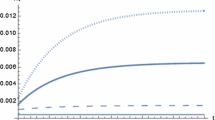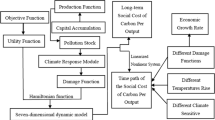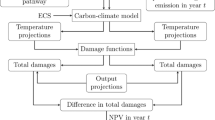Abstract
Recent articles have investigated with integrated assessment models the possibility that climate damage bears on productivity (TFP) growth and not on production. Here, we compare the impact of these alternative representations of damage on the social cost of carbon (SCC). We ask whether damage on TFP growth leads to higher SCC than damage on production ceteris paribus. To make possible a controlled comparison, we introduce a measure of aggregate damage, or damage strength, based on welfare variations. With a simple climate-economy model, we compare three damage structures: quadratic damage on production, linear damage on growth and quadratic damage on growth. We show that when damage strength is the same, the ranking of SCC between a model with damage on production and a model with damage on TFP growth is not unequivocal. It depends on welfare parameters such as the utility discount rate or the elasticity of marginal social utility of consumption.




Similar content being viewed by others
Notes
More accurately the social cost of CO2 as it relates to the impact of a ton of CO2 and not a ton of carbon. This is simply a question of changing units (from $ /tCO2 to $ /tC) and not a different concept. We follow here the majority of the literature by using the terminology social cost of carbon.
There are two different types of IAMs. First, the cost-benefit type concerned in this article. Second, a different type of IAMs, sometimes called process-based IAMs, that explicitly represent the drivers and processes of change in global energy and land use systems linked to the broader economy. The IAMs of this second type do not represent damage from climate change, and are used to analyze transformation pathways to achieve a pre-determined level of mitigation effort such as 2 ∘C climate stabilization, in a cost-effectiveness framework. Examples of process-based IAMs include the models used to quantify the shared socioeconomic pathways [41].
Appendix 1 discusses why this allocation does not control for the magnitude of damage.
What we call “idealine” is usually called “baseline” in the IAM community, in particular in the context of process-based IAMs studies on mitigation pathways and mitigation costs in a cost-effectiveness framework.
This is the same as saying that mitigation gain are always positive, see Eq. 13.
As explained in the main text, damage on production have a second-order cumulative effect through reduced capital accumulation.
References
Anthoff, D., & Tol, R.S.J. (2013). The uncertainty about the social cost of carbon: a decomposition analysis using FUND. Climatic Change, 117(3), 515–530.
Anthoff, D., & Tol, R.S.J. (2009). The impact of climate change on the balanced growth equivalent: An application of FUND. Environmental and Resource Economics, 43(3), 351–367.
Arrow, K.J. (2007). Global climate change: a challenge to policy. The Economists’ Voice, 4(3).
Auffhammer, M., & Schlenker, W. (2013). It’s not just the statistical model. A comment on Seo (2013). Climatic Change, 121(2), 125–128.
Colacito, R., Hoffmann, B., & Phan, T. (2014). Temperatures and growth: a panel analysis of the US., SSRN Scholarly Paper ID 2546456 Social Science Research Network, Rochester, NY.
Committee on Assessing Approaches to Updating the Social Cost of Carbon, Board on Environmental Change and Society, Division of Behavioral and Social Sciences and Education, and National Academies of Sciences, Engineering, and Medicine (2017). Valuing climate changes: Updating estimation of the social cost of carbon dioxide, Washington, DC:National Academies Press, https://doi.org/10.17226/24651.
Dasgupta, P. (2007). The Stern review’s economics of climate change. National Institute Economic Review, 199, 4–7.
Dell, M., Jones, B.F., & Olken, B.A. (2009). Temperature and income: reconciling new cross-sectional and panel estimates. American Economic Review, 99(2), 198–204.
Dell, M., Jones, B F., & Olken, B.A. (2012). Temperature shocks and economic growth: evidence from the last half century. American Economic Journal: Macroeconomics, 4(3), 66–95.
Dell, M., Jones, B.F., & Olken, B.A. (2014). What do we learn from the weather? The new climate-economy literature. Journal of Economic Literature, 52(3), 740–798.
Deryugina, T, & Hsiang, S.M. (2014). Does the environment still matter? Daily temperature and income in the united states, Working Paper 20750, National Bureau of Economic Researchx.
Dietz, S., & Stern, N. (2015). Endogenous growth, convexity of damage and climate risk: how Nordhaus’ framework supports deep cuts in carbon emissions. The Economic Journal, 125(583), 574–620.
Fankhauser, S., & Tol, R.S.J. (2005). On climate change and economic growth. Resource and Energy Economics, 27(1), 1–17.
Gillett, N.P., Arora, V.K., Matthews, D., & Allen, M.R. (2013). Constraining the ratio of global warming to cumulative CO2 emissions Using CMIP5 Simulations*. Journal of Climate, 26(18), 6844–6858.
Godard, O. (2009). Time discounting and long-run issues: the controversy raised by the Stern Review of the economics of climate change. OPEC Energy Review, 33(1), 1–22.
Goodwin, P., Williams, R.G., & Ridgwell, A. (2015). Sensitivity of climate to cumulative carbon emissions due to compensation of ocean heat and carbon uptake. Nature Geoscience, 8(1), 29–34.
Greenstone, M., Kopits, E., & Wolverton, A. (2013). Developing a social cost of carbon for US regulatory analysis: a methodology and interpretation. Review of Environmental Economics and Policy, 7(1), 23–46.
Hope, C. (2013). Critical issues for the calculation of the social cost of CO2: why the estimates from PAGE09 are higher than those from PAGE2002. Climatic Change, 117(3), 531–543.
Hsiang, S. (2016). Climate econometrics. Annual Review of Resource Economics, 8(1), 43–75.
Hsiang, S.M., & Jina, A.S. The causal effect of environmental catastrophe on long-run economic growth: evidence from 6,700 Cyclones, Working Paper 20352, National Bureau of Economic Research.
Tol, K.R.R., & Waldhoff, S. (2012). The social cost of carbon, http://www.economics-ejournal.org/special-areas/special-issues/the-social-cost-of-carbon. Special Issue of Economics: The Open-Access, Open-Assessment E-Journal.
Kopp, R.E., Golub, A., Keohane, N.O., & Onda, C. (2012). The influence of the specification of climate change damages on the social cost of carbon, Economics: The Open-Access, Open-Assessment E-Journal.
Krasting, J.P., Dunne, J.P., Shevliakova, E., & Stouffer, R.J. (2014). Trajectory sensitivity of the transient climate response to cumulative carbon emissions. Geophysical Research Letters, 41(7), 2520–2527.
Leduc, M., Damon Matthews, H., & De Elía, R. (2015). Quantifying the limits of a linear temperature response to cumulative CO 2 emissions. Journal of Climate, 28(24), 9955–9968.
Lucas, R.E., Jr. (1987). Models of business cycles. Oxford: Royaume-Uni, Basic Blackwell.
Lucas, R.E., Jr. (2003). Macroeconomic priorities. American Economic Review, 93(1), 1–14.
Matthews, H.D., Gillett, N.P., Stott, P.A., & Zickfeld, K. (2009). The proportionality of global warming to cumulative carbon emissions. Nature, 459(7248), 829–832.
Mirrlees, J.A., & Stern, N.H. (1972). Fairly good plans. Journal of Economic Theory, 4(2), 268–288.
Moore, F.C., & Diaz, D.B. (2015). Temperature impacts on economic growth warrant stringent mitigation policy. Nature Climate Change, 5(2), 127–131.
Moyer, E.J., Woolley, M.D., Matteson, N.J., Glotter, M.J., & Weisbach, D.A. (2014). Climate impacts on economic growth as drivers of uncertainty in the social cost of carbon. The Journal of Legal Studies, 43 (2), 401–425.
Nordhaus, W.D. (1992). An optimal transition path for controlling greenhouse gases. Science, 258(5086), 1315–1319.
Nordhaus, W.D. (1994). Managing the global commons: the economics of climate change. Cambridge: Mass MIT Press.
Nordhaus, W.D. (2008). A question of balance. London: Yale University Press.
On Social Cost of Carbon, Interagency Working Group (2010). Social Cost of Carbon for Regulatory Impact Analysis under Executive Order 12866. Technical report, United States Government.
On Social Cost of Carbon, Interagency Working Group (2015). Technical Update of the Social Cost of Carbon for Regulatory Impact Analysis Under Executive Order 12866. Technical report, United States Government.
Pindyck, R.S. (2011). Modeling the impact of warming in climate change economics. In Libecap, G., & Steckel, R. (Eds.) The economics of climate change. Chicago: University of Chicago Press.
Pindyck, R.S (2012). Uncertain outcomes and climate change policy. Journal of Environmental Economics and Management, 63(3), 289–303.
Pizer, W., Adler, M., Aldy, J., Anthoff, D., Cropper, M., Gillingham, K., Greenstone, M., Murray, B., Newell, R., Richels, R., Rowell, A., Waldhoff, S., & Wiener, J. (2014). Using andimproving the social cost of carbon. Science, 346(6214), 1189–1190.
Pottier, A., Etienne, E., Perrissin-Fabert, B., & Dumas, P. (2015). The comparative impact of Integrated Assessment Models’ structures on optimal mitigation policies. Environmental Modeling & Assessment, 20(5), 453–473.
Revesz, R.L., Howard, P.H., Arrow, K., Goulder, L.H., Kopp, R.E., Livermore, M.A., Oppenheimer, M., & Sterner, T. (2014). Global warming: Improve economic models of climate change. Nature, 508(7495), 173.
Riahi, K., Vuuren, D.P., Kriegler, E., Edmonds, J, O’Neill, B.C., Fujimori, S., Bauer, N., Calvin, K., Dellink, R., Fricko, O., Lutz, W., Popp, A., Cuaresma, J. C., Samir, K. C., Leimbach, M., Jiang, L., Kram, T., Rao, S., Emmerling, J., Ebi, K., Hasegawa, T., Havlik, P., Humpenöder, F., Da Silva, L.A., Smith, S., Stehfest, E., Bosetti, V., Eom, J., Gernaat, D., Masui, T., Rogelj, J., Strefler, J., Drouet, L., Krey, V., Luderer, G., Harmsen, M., Takahashi, K., Baumstark, L., Doelman, J.C., Kainuma, M., Klimont, Z., Marangoni, G., Lotze-Campen, H, Obersteiner, M., Tabeau, A., & Tavoni, M. (2017). The Shared Socioeconomic Pathways and their energy, land use, and greenhouse gas emissions implications: An overview. Global Environmental Change, 42, 153–168.
Schneider, S.H (1997). Integrated assessment modeling of global climate change: transparent rational tool for policy making or opaque screen hiding value-laden assumptions? Environmental Modeling and Assessment, 2(4), 229–249.
Stern, N. (1977). Welfare weights and the elasticity of the marginal valuation of income. In Artis, M.J., & Nobay, A.R. (Eds.) Studies in modern economic analysis: proceedings of the AUTE Edinburgh meeting of 1976, Chapter 8. Oxford: Basil Blackwell.
Stern, N. (2014). Ethics, equity and the economics of climate change. Paper 1: science and philosophy. Economics and Philosophy, 30(3), 397–444.
Stern, N. (2014). Ethics, equity and the economics of climate change. Paper 2: economics and politics. Economics and Philosophy, 30(3), 445–501.
Stern, N.H. (2006). Stern review: The economics of climate change Vol. 30. London: HM treasury.
Strulik, H. (2015). Hyperbolic discounting and endogenous growth. Economics Letters, 126, 131–134.
Tol, R.S. (2009). The economic effects of climate change. The Journal of Economic Perspectives, 23(2), 29–51.
Tol, R.S. (2014). Correction and update: The economic effects of climate change. The Journal of Economic Perspectives, 28(2), 221–225.
Author information
Authors and Affiliations
Corresponding author
Appendices
Appendix 1
Moyer et al. [30] and [12] rely on the same representation of the impact of climate change on productivity growth. They start from damage bearing only on production, with a damage function D t that depends quadratically on the temperature T t : D t = 1 − Ω(T t ). Net production (that is including climate damage) Q t is reduced by a factor 1 − D t from Y t , the production that would have occurred given factors on production (technology, capital, labor), had climate change not existed: Q t = Y t (1 − D t ).
From this standard case, the current damage D t are then “allocated” between damage on production and damage on TFP growth, a procedure that originates, to our knowledge, from [22]. The TFP growth rate is reduced by f.D t , when the production, instead of being reduced by 1 − D t is reduced by (1 − D t )/(1 − f D t ), where f is the “share” of damage that impact growth. Speaking of an “allocation” of damage conveys the impression that there is the same “amount” of damage.
However, the damage apply on very different quantities. Damage on TFP growth have a (first-order) cumulative effect on the whole output path, whereas damage on production does not.Footnote 7 Far from keeping aggregate damage constant across the scenarios studied, the allocation introduces more damage when f increases. Thus, it is not surprising that these studies find that the SCC increases when more damage are allocated to damage on growth. To illustrate this, we consider two possible ways to measure aggregate damage: the real production loss and the damage strength used in the main text.
Figure 5 plots the real production loss at 3 ∘C (the percentage of production loss between the baseline and the idealine when the temperature increase reaches 3 ∘C) against the theoretical loss (the value of D t when the temperature increase is 3 ∘C), for several “shares” of damage on growth: 0, 2.5, 5, 10, 15, and 20 (percents). Because temperature increase feedbacks on the economic dynamic and thus on emissions, the date at which 3 ∘C is reached changes slightly when the theoretical loss and the “share” vary.
When damage bear only on production, real losses are already higher than the theoretical damage from the damage function (equal theoretical and real damage is represented by the dotted line in Fig. 5). This is due to feedbacks through reduced accumulation of capital. But the difference between real and theoretical losses remains quite small. When the “share” of damage on TFP growth increases, the wedge between the real loss and the theoretical loss increases rapidly. This is of course no surprise, because the damage that reduces long-term growth rates has long-lasting effects. However it has the consequence that damage is much higher at 3 ∘C than what is commonly assumed. This means that the value of reduction of output at 3 ∘C is not kept constant.
Figure 6 plots the damage strength against the theoretical production loss. We can see that theoretical loss and damage strength goes in the same direction. Therefore, when the “share” of damage on TFP growth is kept constant, theoretical loss can be used as a proxy for damage strength. However, when the “share” of damage on TFP growth is changed, the same theoretical loss can lead to highly different damage strengths.
Appendix 2
The model is resolved over a 600 years time horizon, by 5 years time steps. It is calibrated in 2005. Table 2 gives the parameters values.
In addition, four variables follow exogenous trends, as defined below:
g t = g 0 e −χt (exogenous trend of TFP growth)
L t = L 0 e −γt + L ∞ (1 − e −γt) (population)
\(\sigma _{t}=\sigma _{0} e^{-g_{\sigma } t e^{-d_{\sigma } t}} \frac {1+e^{-s_{peak} d_{peak}}}{1+e^{s_{peak} (t-d_{peak})}}\) (exogenous evolution in carbon content of production)
\(\theta _{1}(t)=\sigma _{t} \frac {p_{backstop}}{\theta _{2}} \frac {r_{backstop}-1+e^{-g_{backstop}t}}{r_{backstop}}\) (exogenous decrease of abatement costs)
Table 3 gives the values of the parameters used in these four exogenous trends.
Rights and permissions
About this article
Cite this article
Guivarch, C., Pottier, A. Climate Damage on Production or on Growth: What Impact on the Social Cost of Carbon?. Environ Model Assess 23, 117–130 (2018). https://doi.org/10.1007/s10666-017-9572-4
Received:
Accepted:
Published:
Issue Date:
DOI: https://doi.org/10.1007/s10666-017-9572-4






